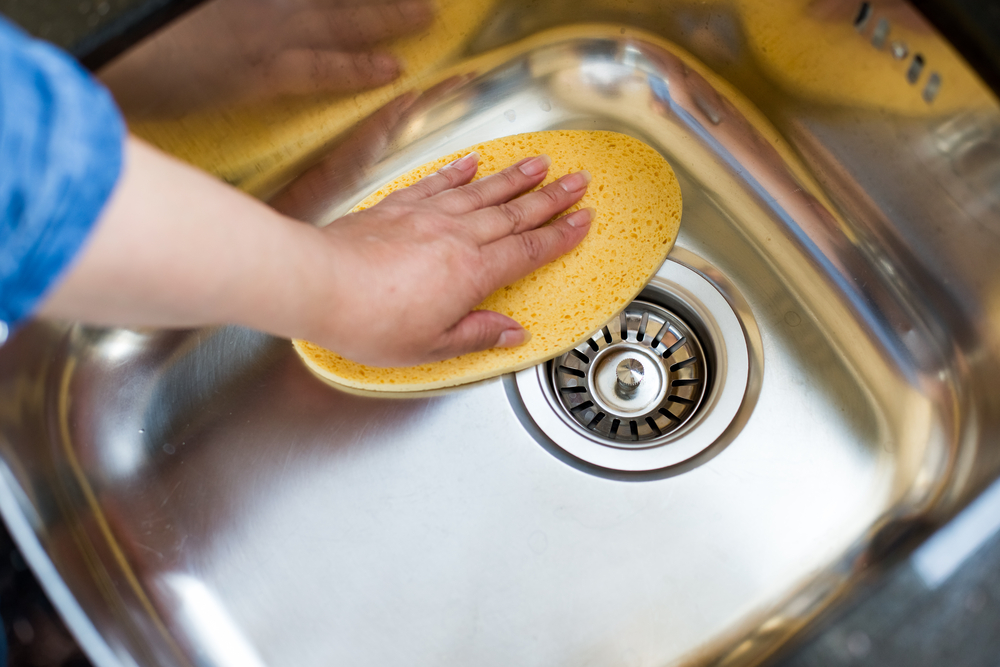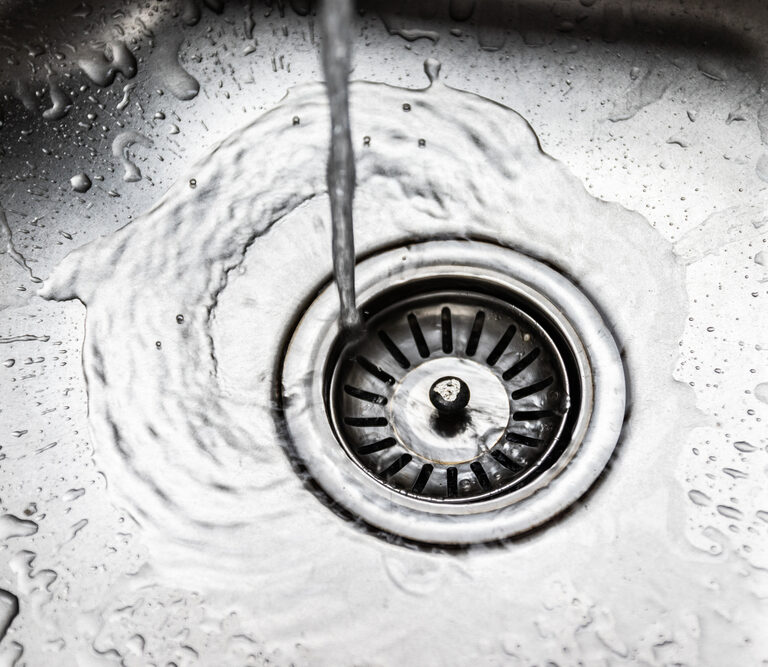Stainless steel sinks have become a staple of kitchen design thanks to their professional look and maximum degree of durability. But anybody who’s encountered a stainless steel sink, or stainless fridge (or any other stainless item, for that matter) knows that “stainless” doesn’t mean “maintenance-free.”
However, by getting into good habits and learning some simple cleaning methods, you can make sure that your prized, expensive stainless steel sink always looks its best.
Daily Cleaning
Keeping your stainless steel sink looking fresh and new means giving it a cleaning just about every day. If you don’t use your sink much on a daily basis, you can adjust how frequently you do this, but for most people, your daily cleaning routine should include the kitchen sink.
For stainless steel sinks, daily cleaning is very simple unless the sink is stained or has lost its luster. It’s helpful to do this at the same time every day (or however often you clean the sink) so that you get into the habit.
- Be sure the sink is empty, and then give it a thorough cleaning with the sprayer or with your hand, ensuring water reaches every area of the sink, including the sides, basin, and if applicable, the faucet Stainless steel is a non-porous surface, so unlike some other types of sinks, it’s actually not possible to clean too much.
- Using a soft dish cloth or soft sponge, apply some warm water and a bit of dish soap. The cloth or sponge should not be filled with suds. Take the cloth or sponge and wipe the sink in the direction of the grain of the metal. It may be hard to tell, but just like wood, the surface of steel has a grain.If the sink has many scratches, it can be difficult to tell which direction the grain runs. But it should still be visible under the scratches; search for an area that’s not scratched to find the grain lines.
- If the sink has some stuck-on food waste, take the abrasive side of the sponge and scrub until it comes off, and then continue cleaning as you were. Rinse your rag or sponge and wipe the entire sink down, again going in the grain of the metal.
- Use the sprayer to rinse the surface of the sink if you need to.
- Once you’re done, get a second soft cloth to dry and buff the surface of the sink, again moving in the direction of the grain. Doing this not only cleans the sink’s surface but restores the luster.
Over time, this process will become much quicker as you will be maintaining the surface rather than cleaning it.
Stain & Streak Removal
Getting rid of the stains and streaks that can mar an otherwise beautiful sink is just about as easy as the method for daily cleaning, and it works for removing spots, stains, streaks, and more.
- The beginning of the process is the same — rinse the sink completely, ensuring no food particles remain and the entire surface of the sink is wet.
- Once the sink basin and sides (and top, if applicable) are wet, sprinkle regular household baking soda over the entire surface, creating a light coating. Using a kitchen sponge with a lightly abrasive side or a medium nylon scrubber (nothing made of metal, as that would create more damage), rub the baking soda, again working in the direction of the grain.
The idea is to rub the baking soda into the surface of the stainless steel, which will make the tiny scratches on the sink’s surface disappear because baking soda is a lightly abrasive substance that can help you remove stuck-on food or hard water stains without damaging the finish of the sink.
- Once you’ve rubbed all the baking soda into the surface, put some vinegar into a spray bottle and mist it over the surface of the sink, including any remaining residue from the baking soda. The resulting chemical reaction will cause some fizzing, which in addition to being kind of cool, also will help break up any additional mineral deposits.
Wait a few minutes until all the fizzing stops; rinse the sink with the sprayer and then dry it with a soft cloth.
- If you’re still dealing with a stubborn stain, make a mixture of vinegar and cream of tartar to apply directly to the stain. Combine one cup of vinegar and about one-quarter cup of cream of tartar (if you don’t have any, check the baking aisle or the spice section of your grocery store). This will create a slightly more abrasive, acidic cleaner than baking soda.
Take the mixture and apply enough to the stain to completely saturate it. After about 5-10 minutes, rinse it away with water, using a lightly abrasive sponge to scrub it away if needed.
In addition to your daily cleaning efforts, it’s best to do a thorough scrubbing with baking soda and vinegar about once every month or two to keep mineral deposits from developing on the surface.

Buffing & Polishing
Preserving the finish of a stainless steel sink is quite a simple task, particularly if you’ve been following the advice in the previous two sections. And it probably can be done with materials you have around the house.
- With a clean, dry sink, take a soft, lint-free cloth (microfiber and flour sack are good for this) and apply a few drops of olive oil. With the oil side down, rub the cloth along the sink in the direction of the grain.
- Be sure to apply the oil evenly to the basin, sides, and divider (if you’ve got a two-sided sink). Avoid spreading the oil onto the faucet or handle, as that’ll only make them slippery.
- Using the other side of the towel (or a new, dry one), wipe off any excess oil.
Depending on how much you use your sink, you can do this once every month or so. Truth be told, you can do this as much as you want, provided you don’t allow excess oil to run down into the drain, which can cause havoc with your plumbing.
Tips for Care & Maintenance
The best way to make sure your stainless steel sink looks good for years to come is to prevent it from becoming scratched or dull in the first place. Here are some tips for maintaining the luster of a stainless steel sink:
Keep the Sink Clean and Dry
If you can’t put stuff in the sink, what’s it for, right? Of course, the easiest way to keep your stainless steel sink from stains, streaks, or any other problems is just never to use. But that’s not realistic.
However, getting in the habit of making sure dishes don’t linger in the sink for long as well as taking a soft kitchen towel and wiping it down after every use are the best ways to keep the sink looking great. If this isn’t possible, perhaps consider placing the dishes on the counter next to the sink until you’re ready to wash them.
Never Use Steel Wool Pads
These types of harsh cleaning products have metal fibers that can scratch and permanently damage the finish of your stainless steel. And they can leave behind those fibers, causing them to rust over time.
Rub the Sink With a Lemon
If you’ve got them on hand, before you start cleaning your stainless steel sink, cut a lemon or other citrus fruit in half and rub the sink basin and sides with the cut side. The citric acid in the fruit can help speed the process of removing stuck-on food particles or dissolving mineral deposits from water. It also creates a lovely aroma.
Try Commercial Products if You Like
There are a few products designed to clean stainless steel appliances, sinks, and even outdoor grills that basically serve the same function as the DIY cleaning methods we described here for times when you might be in too much of a hurry to mix up a batch of your own cleaner. Make sure you follow all instructions the manufacturer provides.
If Your House Has Hard Water, Always Dry the Sink
For those who live in a hard water area, committing to maintaining the shiny finish of the sink requires some habits that may border on obsessive. That’s because standing water, especially in homes with hard water, is the best recipe for spots or rust.
Keep plenty of soft, lint-free cloths or towels on hand and gently dry the sink after every use, rubbing in the direction of the metallic grain to ensure a perfect finish.
Enjoy Your Spotless Stainless Steel Sink
You can keep your stainless steel sink looking polished, sleek, and brand new thanks to these simple methods and tips. By maintaining your sink, you’ll help make sure your kitchen stays gleaming and gorgeous, and you may even find yourself more inspired to cook from home.
Give these methods a try, and see how beautiful your stainless steel sink can be.
